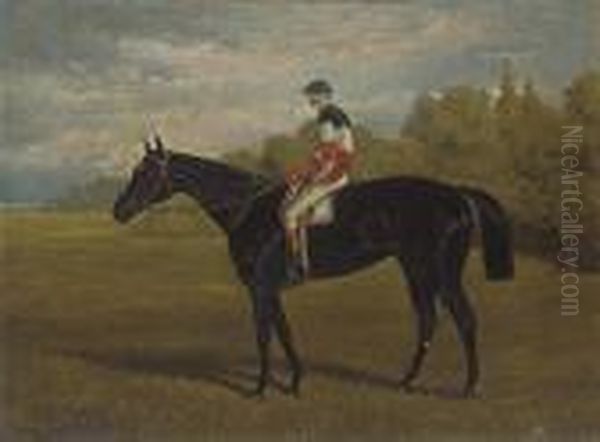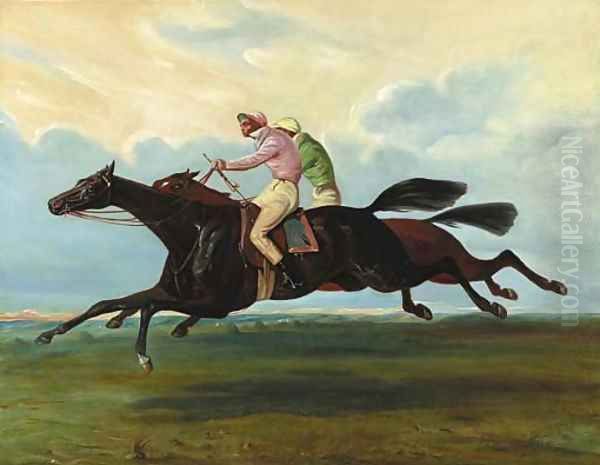Henry Stull (1851-1913) stands as a significant figure in the realm of American sporting art, particularly renowned for his masterful depictions of racehorses. Active primarily in New York, Kentucky, and with connections to Canada, Stull carved a distinct niche for himself through his oil paintings that captured the spirit, power, and elegance of the thoroughbred. His work, deeply influenced by the established British tradition of equine portraiture, brought a sophisticated and detailed eye to the burgeoning American racing scene of the late 19th and early 20th centuries.
The Making of a Sporting Artist
Born in 1851, Henry Stull emerged as an artist during a period of great enthusiasm for horse racing in the United States. While specific details of his early training are not extensively documented in the provided materials, his mature style indicates a thorough understanding of equine anatomy and a keen observational skill. He became particularly associated with the racing circuits of New York and Kentucky, the latter being a crucial hub for thoroughbred breeding and racing. It was in these environments that Stull found his primary subjects and patrons.
His dedication to the genre was profound. From 1879 to 1912, a span of over three decades, Stull consistently produced portraits of racehorses, a testament to his sustained passion and the demand for his work. His paintings were not mere representations; they were character studies of the celebrated equine athletes of his day. This dedication led to his works being highly sought after, with prominent jockey clubs in New York and Brooklyn reportedly holding collections of up to fifty of his paintings each.
Artistic Style and Influences

Stull's artistic approach was characterized by its meticulous detail and a commitment to accuracy. He excelled in capturing the sleek musculature, the sheen of a well-groomed coat, and the individual characteristics of each horse. This precision was a hallmark of the British sporting art tradition, which had been dominated by figures like George Stubbs in the 18th century, whose scientific approach to equine anatomy set a new standard. Later artists such as John Frederick Herring Sr., Benjamin Marshall, and Sawrey Gilpin continued this legacy, creating dynamic and often romanticized portrayals of horses in action or at rest.
Stull absorbed these influences, bringing a similar level of dedication to anatomical correctness and lifelike representation to his canvases. He was known for improving horse painting techniques, particularly in depicting horses with correct posture, moving beyond some of the more stylized or less anatomically sound representations that had sometimes characterized earlier equine art. His oil paintings are noted for their rich textures and careful rendering of light and shadow, which gave his subjects a tangible presence.
A Canvas of Champions: Notable Works and Subjects
Henry Stull's oeuvre is filled with portraits of celebrated racehorses, often commissioned by their wealthy owners or by prestigious racing associations. He had the distinction of painting for prominent figures, including commissions for horses owned by Edward, Prince of Wales, such as the Prince's Diamond Jubilee winner, and various British Triple Crown champions. This international recognition underscores the high regard in which his work was held.
One of his significant American subjects was Iroquois, the first American-bred horse to win the Epsom Derby in England in 1881. Stull’s portrait of Iroquois would have been a prestigious commission, celebrating a moment of national pride in American thoroughbred breeding and racing.
Among his documented representative works is "Great Handicap (Brooklyn Handicap)," painted in 1896. This piece, measuring 18.3 x 28.3 inches, captures the excitement and competitive spirit of a major racing event. Another notable painting, "A Racehorse with Jockey Up," created between 1893 and 1895, exemplifies his skill in depicting the dynamic partnership between horse and rider, a recurring theme in his work. "Great Eastern Handicap," depicting a race at Gravesend in 1895 and completed in 1896, and "Heads Apart" (1898), showcasing a thrilling finish at the Queens County Jockey Club, further illustrate his focus on the drama of the turf.
His process often involved direct observation and sketching. He would undertake trips, for instance to Kentucky, to observe horses in their natural environment and at the track, gathering material that he would later develop into finished oil paintings in his New York City studio. This commitment to firsthand study contributed to the authenticity and vitality of his work.
Stull's Immersion in the Racing World

Henry Stull was not merely an observer of the racing world; he was an active participant and enthusiast. His passion for thoroughbreds extended beyond the canvas. He was known to have purchased racehorses himself, and notably, he painted a portrait of one of his own horses, Brad Law, in 1902. This personal investment in the sport undoubtedly deepened his understanding and appreciation of his subjects.
His connections within the racing community were strong. Stull was a member of the Coney Island Jockey Club, one of the prominent racing organizations of the era. This membership would have provided him with unparalleled access to the horses, owners, trainers, and jockeys who populated this vibrant world, further enriching his artistic practice. His studio became a repository of racing knowledge, translating the fleeting moments of the track into enduring artistic statements.
European Sojourns and International Acclaim
While firmly rooted in the American art scene, Stull also sought inspiration and opportunities abroad. He traveled to Europe, a common practice for ambitious American artists of his time who wished to study the old masters and engage with contemporary European art movements. For Stull, these travels would have also allowed him to immerse himself further in the British and European traditions of sporting art and to connect with international patrons.
His commissions to paint for European clients, including the aforementioned works for the Prince of Wales, demonstrate that his reputation transcended national borders. The ability to secure such prestigious commissions speaks volumes about the quality of his art and his standing in the international sporting art community. These experiences would have broadened his artistic horizons and reinforced his commitment to the high standards of equine portraiture.
Contemporaries and Artistic Milieu
Henry Stull operated within a rich artistic landscape. In the specific field of American sporting art, he is often mentioned alongside Edward Troye (1808-1874), an earlier artist who is widely considered one of the most important American equine painters of the 19th century. Troye, like Stull, was known for his detailed and accurate portrayals of thoroughbreds. While Troye's career largely preceded Stull's peak, his work set a benchmark for American sporting artists.
The provided information also mentions that Stull copied sketches by Richard Hewitt Moore. This suggests an interaction or influence, perhaps Moore being an elder contemporary or an artist whose work Stull admired and studied. The act of copying was a traditional method of artistic learning and homage.
Beyond the immediate sphere of sporting art, the late 19th century in America saw a flourishing of various artistic styles. Realists like Thomas Eakins were making profound anatomical studies, including scenes of rowing and boxing, which shared a certain kinship with sporting art's focus on athleticism. Landscape painters of the Hudson River School, such as Albert Bierstadt and Frederic Edwin Church, were still influential, though their grand romantic visions differed greatly from Stull's specialized focus. Meanwhile, artists like Winslow Homer captured scenes of American life, including sporting activities like hunting and fishing, with a rugged naturalism.
In Europe, Impressionism had taken hold, with artists like Edgar Degas famously depicting racecourses and horses, though with a stylistic approach vastly different from Stull's detailed realism. Degas focused on movement, light, and the fleeting moment, often using unconventional compositions. While Stull remained committed to a more traditional, realistic style, the broader artistic currents of the time formed the backdrop to his career. Other American artists who sometimes touched upon animal or sporting themes, though perhaps not as exclusively as Stull, included Arthur Fitzwilliam Tait, known for his depictions of wildlife and hunting scenes. Later, in the early 20th century, artists like Frederic Remington would become iconic for their portrayals of the American West, often featuring horses in dramatic action, albeit in a different context from the racetrack.
Legacy and Enduring Presence
Henry Stull's contributions to American art, particularly within the specialized genre of sporting painting, are significant. His works serve as both artistic achievements and historical documents, capturing the likenesses of legendary thoroughbreds and offering a glimpse into the racing culture of his era. His dedication to realism and his technical skill ensured that his paintings were highly valued during his lifetime and continue to be appreciated today.
His paintings are held in important collections that reflect his specialization. These include the New York Jockey Club, a testament to his close ties with the racing establishment. The National Museum of Racing and Hall of Fame in Saratoga Springs, New York, and the Kentucky Derby Museum in Louisville, Kentucky, also house his works, underscoring his importance in the visual history of American horse racing. Furthermore, his art has appeared in collections such as the Penkhurst Collection in London and has been featured in auctions, for example, at the Dallas Auction Gallery, indicating a continued market interest.
The fact that every major jockey club in New York and Brooklyn held substantial numbers of his paintings speaks to his preeminence in his chosen field. He was, in essence, the visual chronicler of the turf for a generation of racing enthusiasts and horse owners. His influence can also be seen in the work of later American sporting artists, such as Franklin B. Voss, who continued the tradition of equine portraiture into the 20th century. Even the great British equine artist Sir Alfred Munnings, whose career peaked after Stull's death, worked within a similar tradition of celebrating the horse in sport.
Conclusion: A Dedicated Chronicler of the American Turf
Henry Stull's career was a testament to focused dedication and artistic skill. He chose a specialized genre and excelled within it, becoming one of America's foremost painters of racehorses. His work, characterized by its precision, realism, and deep understanding of its subject matter, captured the excitement and elegance of the thoroughbred racing world. Influenced by British masters yet distinctly American in his context, Stull created a body of work that not only pleased his patrons but also left an enduring legacy.
His paintings offer more than just aesthetic pleasure; they are windows into a specific time and place, reflecting the passion for horse racing that captivated America in the late 19th and early 20th centuries. Through his art, Henry Stull immortalized the equine champions of his day and secured his own place in the annals of American art history as a distinguished and prolific sporting artist. His legacy continues to be celebrated in museums and collections dedicated to both art and the rich history of horse racing.